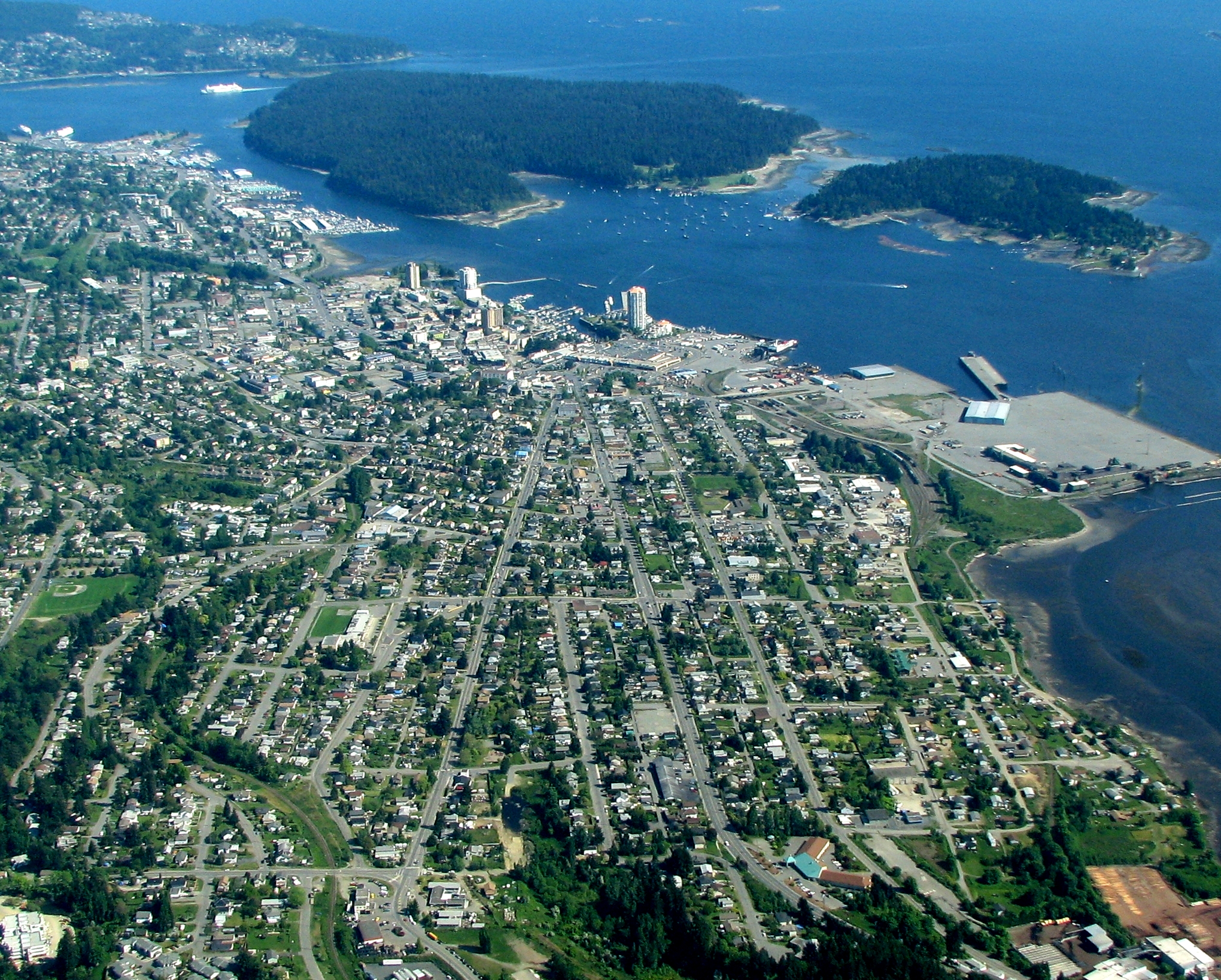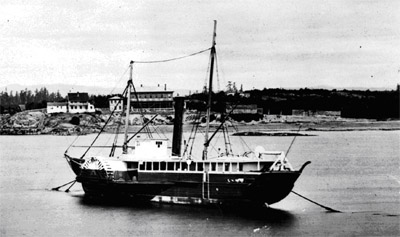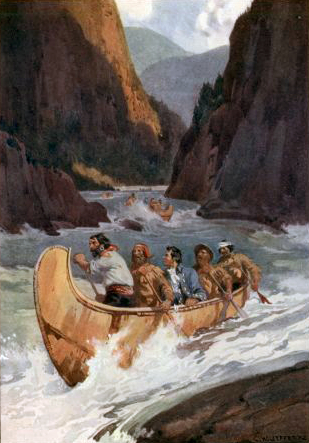|
Nanaimo Bastion
The Nanaimo Bastion is a historical octagon-shaped blockhouse located at 98 Front Street in Nanaimo, British Columbia, Canada. The Hudson's Bay Company, which then held a royal lease on all of what was then the Colony of Vancouver Island, built it between 1853 and 1855 to defend its coal mining operations in Nanaimo. It has been called "Nanaimo's premier landmark", because of its shape and its high visibility from both land and sea. The Bastion was constructed using the pièce-sur-pièce (post-and-plank) method. This entailed laying timbers across each other horizontally, with tenons cut into the ends. These tenons would then be inserted into vertical posts. This method was used partially due to the expensive cost of nails; by using the pièce-sur-pièce method, very few nails were needed. The logs were squared using only basic hand tools: a crosscut saw, broadaxe, adze, auger and pit saw. The wooden structure sat on a masonry foundation and was three stories tall. It is the only ... [...More Info...] [...Related Items...] OR: [Wikipedia] [Google] [Baidu] |
Nanaimo
Nanaimo ( ) is a city on the east coast of Vancouver Island, in British Columbia, Canada. As of the Canada 2021 Census, 2021 census, it had a population of 99,863, and it is known as "The Harbour City." The city was previously known as the "Hub City," which was attributed to its original layout design, whose streets radiated from the shoreline like the spokes of a wagon wheel, and to its central location on Vancouver Island. Nanaimo is the headquarters of the Regional District of Nanaimo. Nanaimo is served by the coast-spanning Island Highway, the Island Rail Corridor, the BC Ferries system, and a local airport. History The Indigenous peoples of the area that is now known as Nanaimo are the Snuneymuxw. An anglicised spelling and pronunciation of that word gave the city its current name. The first Europeans known to reach Nanaimo Harbour were members of the 1791 Spanish voyage of Juan Carrasco (explorer), Juan Carrasco, under the command of Francisco de Eliza. They gave it ... [...More Info...] [...Related Items...] OR: [Wikipedia] [Google] [Baidu] |
Vancouver Island
Vancouver Island is an island in the northeastern Pacific Ocean and part of the Canadian Provinces and territories of Canada, province of British Columbia. The island is in length, in width at its widest point, and in total area, while are of land. The island is the largest by area and the most populous along the west coasts of the Americas. The southern part of Vancouver Island and some of the nearby Gulf Islands are the only parts of British Columbia or Western Canada to lie south of the 49th parallel north, 49th parallel. This area has one of the warmest climates in Canada, and since the mid-1990s has been mild enough in a few areas to grow Mediterranean Sea, Mediterranean crops such as olives and lemons. The population of Vancouver Island was 864,864 as of 2021. Nearly half of that population (~400,000) live in the metropolitan area of Greater Victoria, the capital city of British Columbia. Other notable cities and towns on Vancouver Island include Nanaimo, Port Alberni, ... [...More Info...] [...Related Items...] OR: [Wikipedia] [Google] [Baidu] |
List Of Coal Mines And Landmarks In The Nanaimo Area
This is a list of landmarks and historic locations, mostly related to coal mining, in the vicinity of the City of Nanaimo in the Canadian province of British Columbia. Origins of Nanaimo - Coal Most of these landmarks relate to the city's history as a coal-mining town. Coal was discovered in the area in 1849. Joseph William McKay took possession of the deposits for the Hudson's Bay Company (HBC) in 1852 at the direction of Governor James Douglas. The area was first known as Wintuhuysen Inlet and then Colvile Town (named for HBC Governor Andrew Colvile) but became known as Nanaimo in 1860. The first church opened in 1861. In 1853 the population was 125. By 1869 it was about 650 and by 1874 it was close to 1,000. By 1859, 25,000 tons of coal had been shipped from Nanaimo, mostly to San Francisco. In 1862 the HBC sold its coal interests to an English Company known as the Vancouver Coal Mining and Land Company (VCML). Output was 100 tons a day by 1863 and double that by 1866. By 187 ... [...More Info...] [...Related Items...] OR: [Wikipedia] [Google] [Baidu] |
Nanaimo Harbour
Nanaimo Harbour, also known as the ''Port of Nanaimo'', is a natural harbour on the east coast of Vancouver Island, British Columbia, Canada. The City of Nanaimo runs along the west side of the harbour. Three islands, Newcastle, Protection, and Gabriola, along with Duke Point, form the eastern edge. The Port of Nanaimo includes the Inner Harbour, Nanaimo River estuary, Departure Bay, the waters on the east side of Newcastle and Protection Islands, and Northumberland Channel. The port is under the management of the Nanaimo Port Authority. History Long before Europeans arrived, the indigenous Coast Salish lived in the area and used the harbour, its islands, bays, and inlets for hunting, fishing, gathering, and shelter. They built longhouses from the abundant supply of timber surrounding the harbour. The first European in the area was a Spanish Naval Officer in 1791 named Juan Carrasco. He named the bay ''Bocas de Winthuysen''. Carrasco also named several other places in the ... [...More Info...] [...Related Items...] OR: [Wikipedia] [Google] [Baidu] |
List Of Historic Places In The Nanaimo Regional District
The following list includes all of the Canadian Register of Historic Places listings in Nanaimo Regional District, British Columbia British Columbia (commonly abbreviated as BC) is the westernmost province of Canada, situated between the Pacific Ocean and the Rocky Mountains. It has a diverse geography, with rugged landscapes that include rocky coastlines, sandy beaches, .... See also * List of coal mines and landmarks in the Nanaimo area References :''(references appear in the table above as external links) {{Canadian Register of Historic Places listings in British Columbia Nanaimo Regional District ... [...More Info...] [...Related Items...] OR: [Wikipedia] [Google] [Baidu] |
James Douglas (governor)
Sir James Douglas (August 15, 1803 – August 2, 1877) was a Canadian fur trader and politician who became the first Governor of the Colony of British Columbia. He is often credited as "The Father of British Columbia." He was instrumental to the resettlement of 35 African-Americans fleeing a life of racial persecution in San Francisco who arrived in the province aboard the steampship ''Commodore'' in what later became known as the Pioneer Committee. In 1863, Douglas was knighted by Queen Victoria for his services to the Crown. He started work at 16 for the North West Company and then the Hudson's Bay Company and became a high-ranking officer. From 1851 to 1864, he was Governor of the Colony of Vancouver Island. In 1858, he became the first Governor of the Colony of British Columbia and asserted the authority of the British Empire during the Fraser Canyon Gold Rush, which had the potential to turn the Mainland into an American state. He remained governor of both colonies until ... [...More Info...] [...Related Items...] OR: [Wikipedia] [Google] [Baidu] |
Carronade
A carronade is a short, smoothbore, cast-iron cannon which was used by the Royal Navy. It was first produced by the Carron Company, an ironworks in Falkirk, Scotland, and was used from the mid-18th century to the mid-19th century. Its main function was to serve as a powerful, short-range, anti-ship and anti-crew weapon. The technology behind the carronade was greater dimensional precision, with the shot fitting more closely in the barrel thus transmitting more of the propellant charge's energy to the projectile, allowing a lighter gun using less gunpowder to be effective. Carronades were initially found to be very successful, but they eventually disappeared as naval artillery advanced, with the introduction of rifling and consequent change in the shape of the projectile, exploding shells replacing solid shot, and naval engagements being fought at longer ranges. History The carronade was designed as a short-range naval weapon with a low muzzle velocity for merchant ships, b ... [...More Info...] [...Related Items...] OR: [Wikipedia] [Google] [Baidu] |
Otter (steamship)
''Otter'' was the second steamship to operate in the Pacific Northwest of North America, following her sister ship and twin, the much more famous '' Beaver''. ''Otter'', a sidewheeler, was used to service trading posts maintained by the Hudson's Bay Company between Puget Sound and Alaska and like her sister ''Beaver'' became pressed into service during the Fraser Gold Rush on the Lower Fraser River from 1858 onwards. From 16 April 1855 to 3 April 1862, ''Otter'' was captained by William Alexander Mouat. She was built in London, for the Hudson's Bay Company. She sank on August 21, 1880, but was raised and put back into operation. She was sold to the Canadian Pacific Navigation Company in 1883. They converted her to a coal hulk in 1886. Her hull was burned to recover the copper in 1895. See also * List of steamboats on the Columbia River * List of ships in British Columbia The following is a list of vessels notable in the history of the Canadian province of British ... [...More Info...] [...Related Items...] OR: [Wikipedia] [Google] [Baidu] |
Beaver (steamship)
''Beaver'' was a steamship originally owned and operated by the Hudson’s Bay Company. She was the first steamship to operate in the Pacific Northwest of North America, and made remote parts of the west coast of Canada accessible for maritime fur trading. At one point she was chartered by the Royal Navy for surveying the coastline of British Columbia. She served off the coast from 1836 until 1888, when she was wrecked. Service ''Beaver'' served trading posts maintained by the Hudson's Bay Company between the Columbia River and Russian America (Alaska) and played an important role in helping maintain British control in British Columbia during the Fraser Canyon Gold Rush of 1858–59. In 1862 the Royal Navy chartered her to survey and chart the coast of the Colony of British Columbia. She also provided assistance to the Royal Navy at Bute Inlet during the Chilcotin War. Loss A consortium that became the British Columbia Towing and Transportation Company in 1874 purchased her ... [...More Info...] [...Related Items...] OR: [Wikipedia] [Google] [Baidu] |
Fort Langley National Historic Site
Fort Langley National Historic Site, commonly shortened to Fort Langley, is a former fur trading post of the Hudson's Bay Company in the community of Fort Langley of Langley, British Columbia, Canada. The national historic site sits above the banks of the Bedford Channel across McMillan Island. The national historic site contains a visitor centre and a largely reconstructed trading post that contains ten structures surrounded by wooden palisades. Fort Langley was initially established in 1827 in present-day Derby. The fort's operations were later relocated to present-day Langley with the new fort completed in 1839. However, the new fort would be rebuilt in the following year, after a fire ravaged the trading post. The fort continued to see use by the Hudson's Bay Company until 1886, when the company ceased to operate the site as a trading post. By the 1920s, only one building remained at the site, the fort's storehouse. The site was later acquired by the government of Canada in ... [...More Info...] [...Related Items...] OR: [Wikipedia] [Google] [Baidu] |
Victoria, British Columbia
Victoria is the capital city of the Canadian province of British Columbia, on the southern tip of Vancouver Island off Canada's Pacific coast. The city has a population of 91,867, and the Greater Victoria area has a population of 397,237. The city of Victoria is the 7th most densely populated city in Canada with . Victoria is the southernmost major city in Western Canada and is about southwest from British Columbia's largest city of Vancouver on the mainland. The city is about from Seattle by airplane, seaplane, ferry, or the Victoria Clipper passenger-only ferry, and from Port Angeles, Washington, by ferry across the Strait of Juan de Fuca. Named for Queen Victoria, the city is one of the oldest in the Pacific Northwest, with British settlement beginning in 1843. The city has retained a large number of its historic buildings, in particular its two most famous landmarks, the Parliament Buildings (finished in 1897 and home of the Legislative Assembly of British Columbia ... [...More Info...] [...Related Items...] OR: [Wikipedia] [Google] [Baidu] |
Fort Victoria (British Columbia)
Fort Victoria began as a fur trading post of the Hudson’s Bay Company and was the headquarters of HBC operations in the Columbia District, a large fur trading area now part of the province of British Columbia, Canada and the U.S. state of Washington. Construction of Fort Victoria in 1843 highlighted the beginning of a permanent British settlement now known as Victoria, the capital city of British Columbia. The fort itself was demolished in November 1864 as the town continued to grow as a commercial centre serving the local area as well as trading with California, Washington Territory, the United Kingdom, and others. The location of Fort Victoria was designated a National Historic Site of Canada in 1924. History The original headquarters of HBC operations on the Pacific Coast of North America at the time of Victoria's founding was Fort Vancouver (now Vancouver, Washington) on the lower Columbia River, but its location was difficult to defend, ships often had difficulty enteri ... [...More Info...] [...Related Items...] OR: [Wikipedia] [Google] [Baidu] |







_VICTORIA_FROM_JAMES'_BAY_LOOKING_UP_GOVERNMENT_STREET.jpg)